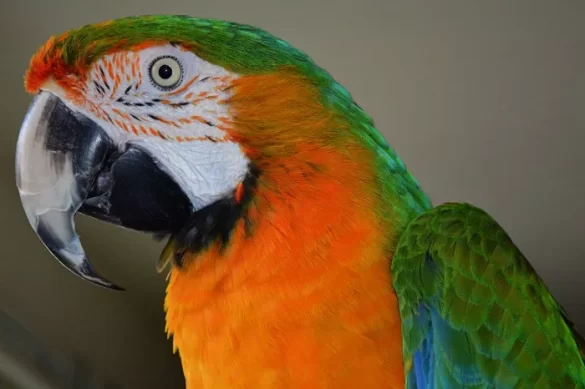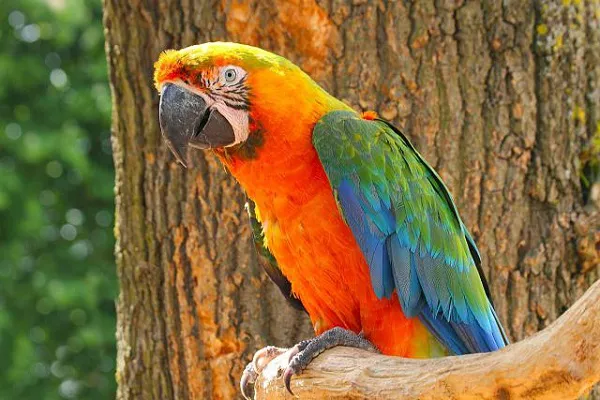The Catalina macaw is a beautiful bird and a popular hybrid parrot known for its bright colors and friendly nature. It is a cross between two famous macaw species: the blue-and-gold macaw and the scarlet macaw. This unique bird is loved by many bird enthusiasts and pet owners because of its beauty, intelligence, and playful personality.
In this article, you will learn everything about the Catalina macaw-from its origin and physical features to its behavior, diet, health, and care tips.
What Is a Catalina Macaw?
The Catalina macaw is a first generation macaw hybrid, meaning it is a mix of two different macaw species. It is created by breeding a blue-and-gold macaw (Ara ararauna) with a scarlet macaw (Ara macao), making it a hybrid ara ararauna. Because it is a hybrid, it does not have its own scientific name but is usually represented as Ara ararauna × Ara macao.
This bird is sometimes called the “rainbow macaw” because of its bright and colorful feathers. The Catalina macaw combines the best traits of both parent species: the friendly nature of the blue-and-gold macaw and the striking beauty of the scarlet macaw.
Origin and History
The Catalina macaw was first bred in captivity at the Catalina Bird Park on Santa Catalina Island, California, in 1940. This is where the bird gets its name. While hybrid macaws can sometimes occur naturally, most Catalina macaws today are bred by humans through selective bird breeding.
Catalina macaws are found mainly in captivity. You seldom find a naturally bred Catalina macaw in the wild. Breeders often choose a male scarlet macaw and a female blue-and-gold macaw to produce these hybrids because the father’s genes tend to be dominant. This means the bird’s colors and some traits are usually more like the scarlet macaw. It is also possible to breed two Catalina parents together to create second-generation hybrids.
Hybrid macaws have become popular in the pet trade. Catalina Macaws are one of the most loved hybrid macaws in the world today.
Physical Description
Catalina macaws are large and beautiful birds with a long, tapering tail. Here are some key facts about their appearance:
- Size: They can grow up to 35 inches (89 cm) long from beak to the tip of the tail feathers.
- Weight: They usually weigh between 2 to 3 pounds (0.9 to 1.4 kg).
- Wingspan: Their wingspan ranges from 40 to 45 inches (100 to 110 cm).
- Lifespan: The average Catalina macaw lives up to 60 years in captivity, sometimes even longer with proper care.
Catalina macaws Colors
Their feathers show a mix of bright colors, including orange, yellow, green, blue, and red, which are characteristic of Catalina macaw colors. Some will have a gorgeous blue green crown, adding to their visual appeal. They are primarily red or deep orange on their chest and bellies. The exact colors depend on the genes inherited from the parents. The color traits of these macaws include brilliant red-orange heads and blue-green crowns. They tend to have green and blue feathers running down their backs and long tails. Many of them have gold feathers edging their wings and their tails.
The bright colors come from special pigments called psittacofulvins, which create red, orange, and yellow shades. The blue and green colors are due to the structure of the feathers and a mix of pigments, not pigments alone.
Behavior and Personality
Catalina macaws are highly intelligent birds that possess traits reminiscent of both scarlet macaws and blue and gold macaws. Scarlet macaws are known to be curious, feisty, and extremely active. In contrast, blue and gold macaws have a reputation for being more laid-back. Catalina macaws are known for their lively and social behavior. Here are some important points about their personality:
Catalina macaws are also great talkers, capable of developing a significant vocabulary. Many can learn around 15 words and phrases throughout their lives, demonstrating their intelligence and social nature, which makes them appealing companions for families.
Vocalizations
Many Catalina macaws are very vocal and can be quite loud. They can scream up to 100-106 decibels, which is as loud as a rock concert or a jackhammer. They use their loud calls to communicate excitement, boredom, or to get attention.
Although they are not the best talkers compared to some other parrots, Catalina macaws can learn to speak up to 15 words or phrases over their lifetime. They enjoy interacting with people and other birds, often using “contact calls” when they feel lonely in an attempt to reconnect with their human “flock”.
Social Needs
In the wild, macaws live in flocks, so they are very social animals. When kept as pets, they see their human caregivers as their flock. This means they need a lot of attention and interaction. Catalina macaws need at least 2 to 4 hours of social interaction and exercise every day to prevent behavioral issues such as feather picking.
Playfulness and Intelligence
Catalina macaws are highly intelligent and playful. They enjoy toys, games, and training sessions. They can learn tricks and respond well to positive reinforcement. Because they are smart, they need mental stimulation to stay happy and healthy.
Diet and Nutrition
Macaws eat a diet rich in seeds, fruits, and vegetables to meet their nutritional needs. Their diet should include:
- Seeds and nuts: These provide essential oils and calories. Ensure you use a high quality seed mix.
- Fruits: Apples, pears, grapes, bananas, mangoes, berries, and papayas are good choices.
- Vegetables: Carrots, sweet potatoes, cucumbers, zucchini, and leafy greens are healthy options.
- Pellets: Special parrot pellets from pet stores can be used but should be combined with fresh foods to create a balanced pellet mix.
Because the Catalina macaw is a large parrot, it requires a diet rich in nutrients and calories to support its energy levels.
Avoid giving them chocolate, caffeine, avocado, alcohol, or salty foods. These are toxic to birds.
Clean, fresh water should always be available.
Health and Common Diseases
Like all birds, Catalina macaws can face several health issues. Some common diseases and problems include:
- Avian bornaviral ganglioneuritis (ABV)
- Allergies
- Beak malformations
- Bacterial, viral, or fungal infections
- Psittacosis (parrot fever)
- Toxicity from harmful substances
- Kidney disease
- Psittacine beak and feather disease (PBFD)
- Cloacal papillomas
Signs of illness may include weight loss, changes in behavior, excessive saliva, feather problems, weakness, breathing difficulties, ruffled feathers, diarrhea, or watery eyes. A dulling of their bright feathers can also indicate poor health.
Psittacosis is especially important because it can spread from birds to humans, causing flu-like symptoms or more severe illness. New birds should be quarantined and tested before joining other birds to prevent disease spread.
Avian bornavirus affects the nervous system and can be fatal if untreated. Regular veterinary check-ups and good hygiene help keep Catalina macaws healthy and can also prevent behavioral issues like feather picking.
Catalina Macaw vs Other Hybrid Macaws
| Feature | Catalina Macaw | Blue and Gold Macaw | Scarlet Macaw |
|---|---|---|---|
| Origin | Hybrid | Pure species | Pure species |
| Colors | Mixed (red, gold, blue) | Blue and gold | Red, yellow, blue |
| Talking Ability | Good | Good | Moderate |
| Personality | Playful and social | Gentle and friendly | Bold and strong-willed |
| Availability | Captive-bred only | Wild and captive | Wild and captive |
The significant difference between the Catalina macaw and other macaws lies in its hybrid origin and mixed colors.
The most significant difference between the Catalina macaw and the harlequin macaw is the Catalina’s longer, tapering tail, which is characteristic of the scarlet macaw.
Training and Socialization
Training is essential for raising a well-behaved and highly intelligent Catalina macaw. Here are some tips:
- Use positive reinforcement like treats and praise.
- Keep training sessions short (about 20 minutes).
- Be patient and consistent.
- Avoid physical or emotional punishment.
- Repeat words and commands clearly and consistently to teach talking.
- Socialize the bird by allowing it to explore, meet new people and birds, and try new toys and foods.
Proper socialization helps prevent behavior problems like aggression or feather plucking. A well-trained and socialized Catalina macaw is confident, playful, and happy.
Is a Catalina Macaw Right for You?
Before you bring home a Catalina Macaw, ask yourself:
- Can I give the bird daily attention?
- Do I have enough space?
- Can I afford vet care and quality food?
- Am I ready for a pet that lives 50+ years?
If you answer yes, a Catalina Macaw can become your best feathered friend. They are loving, smart, and full of life. The average Catalina lives up to 60 years in captivity, so be prepared for a long-term commitment.
Conclusion
The Catalina macaw is such a beautiful bird and a remarkable hybrid that combines the best features of the blue-and-gold and scarlet macaws. With its vibrant colors, playful nature, and ability to mimic human speech, it is a favorite among bird lovers. However, owning a Catalina macaw requires dedication to its social, dietary, and health needs. Proper training and socialization can help these birds thrive as happy and well-behaved pets.
If you are considering a Catalina macaw, be prepared to provide a loving home with plenty of attention, a balanced diet, and regular health care. In return, you will have a colorful, intelligent companion for many years to come.
FAQs
How Smart Are Catalina Macaws?
These birds are very smart. They can learn to:
- Say words and short sentences
- Copy sounds
- Perform tricks
- Use simple logic
They also know how to open cage doors, solve puzzles, and figure things out. Catalina Macaws need mental stimulation every day. Without it, they can become bored or even depressed.
Do Catalina Macaws Talk?
Yes, Catalina Macaws can talk. They can learn up to about 15 words or phrases over their lifetime. While they may not be as impressive talkers as some other parrots, they are highly vocal and use loud calls to communicate, especially when excited or bored. Consistent training and social interaction help improve their speaking abilities.
Are Catalina Macaws Good Pets?
Catalina Macaws can make good pets for those who have the time, experience, and patience to care for them. They are social, affectionate, and can form strong bonds with their owners. However, they require a lot of attention, mental stimulation, and socialization to stay happy and healthy. They are not suitable for apartment living due to their loud vocalizations and need for interaction.
Are Catalina Macaws Rare?
Catalina Macaws are hybrid macaws, bred from a Scarlet Macaw and a Blue-and-Gold Macaw. While not as commonly found as pure species macaws, they are not considered extremely rare but are less common than their parent species. Their unique hybrid status makes them somewhat special in the pet bird community.
What is the Temperament of a Catalina Macaw?
Catalina Macaws have a temperament that reflects a balance between their parent species. They can be playful, affectionate, and charming, but also sometimes cranky with demanding social needs. They thrive on interaction and can become one-person birds, sometimes showing preference for a particular person. Proper socialization from a young age helps them become confident and well-adjusted pets. They are intelligent, social, and require regular mental stimulation and companionship to prevent behavioral issues.




 Facebook
Facebook  Instagram
Instagram  Youtube
Youtube 